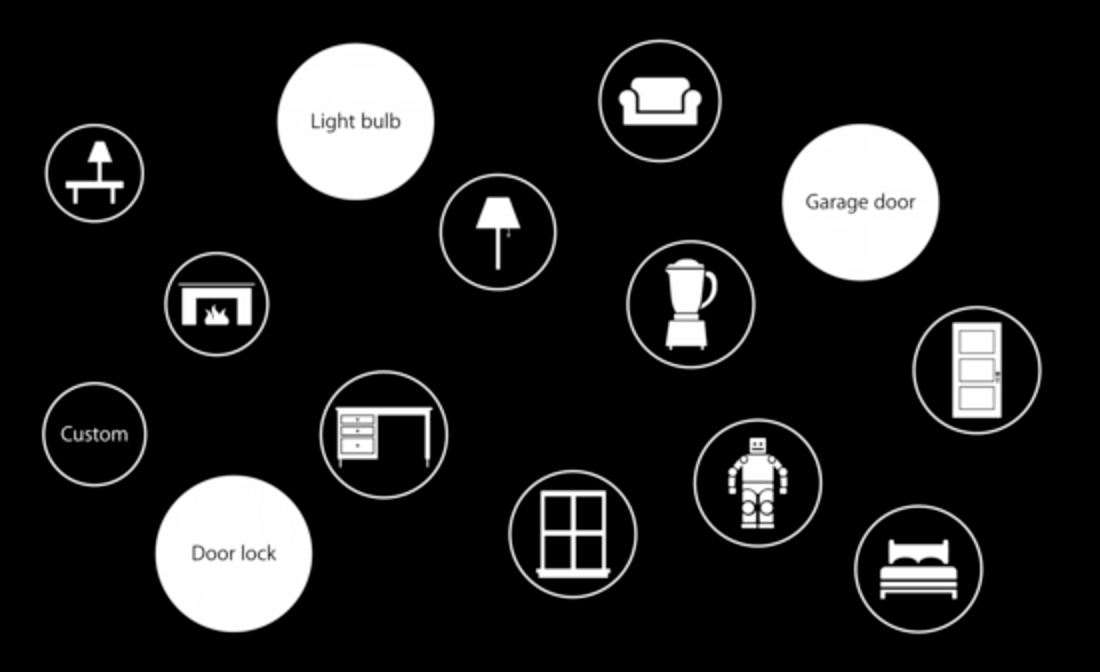As follows any new announcement from Apple, the world's most secretive consumer electronics company, the days since the the unveiling of HomeKit — Apple's new "smart home" platform — have been filled with rumors and speculation about where it might go. AppleInsider now steps back to take a look at the most likely scenario.
The promise of so many mid-century science fiction stories is now closer to reality than it has been at any point since the invention of the transistor: our homes are coming alive, learning to respond to and even anticipate our needs. One could, if one was so inclined, at this very moment knit together any of a number of free web services and devices available at local hardware stores to have their home lighting, security, ventilation, and audiovisual systems respond automatically to their owner's presence or absence.
But it's difficult. Not in the way that doing very large-scale integration for processor design is difficult, but in the same way that getting the $0.20 clocks on your microwave, oven, and television to display the same time at the same time is difficult.
As Steve Jobs would have said, it's a bag of hurt.
The State of the Home (automation system)
The easiest way for homeowners to give their house an education is to contract a professional to install a proprietary system from companies like Crestron. These work exceptionally well, but they can cost tens of thousands of dollars and generally don't play well with others: expansion requires another significant investment, not just plugging in a new bulb and connecting it to your Wi-Fi.
Today's crop of smart home devices is trying to run an end-around on these established systems. This is 2014, the thinking goes, and technology that can make people's lives easier should be available to everyone, not just those who can meet their yacht in Saint-Tropez each June.
Unfortunately, everyone has a slightly different idea of what that should look like.
As AppleInsider has shown in the past, the consumer smart home market is massively fragmented. Many devices use competing standards, some use proprietary protocols, and few can even speak between themselves — never mind talking to each other.
Enter HomeKit
Apple has aimed HomeKit squarely at the root of the problem: interoperability. HomeKit is designed to abstract away the difficult job of managing connections between smart home devices and instead allow control interfaces to speak a single, common language whether they're talking to a garage door opener, a light bulb or a lock.
Users, Apple believes, shouldn't have to put up with using five different apps to control five different aspects of their home. Likewise, developers shouldn't have to reverse-engineer protocols or work to support five divergent control schemes.
Apple's thousands of engineers haven't created HomeKit out of the goodness of their hearts, of course. They need to sell iOS devices, and one of the ways they've chosen to go about it is by creating an ecosystem that makes users' lives easier for having chosen an iPhone over a Nokia handset or an iPad instead of a Galaxy Tab.
The seemingly obvious extension of that strategy is for Apple to move past the HomeKit software solution and design their own line of connected light bulbs and locks, and multiple rumors are now circulating to that effect. To think this way, though, is to ignore Apple's entire history when it comes to developer platforms.
Apple's platform history
The generally accepted premise behind Apple's recent success is one of control. Apple wants to dictate the user experience from beginning to end, a position spurred by Jobs's favorite Alan Kay quote — "people who are really serious about software should make their own hardware."
Since the beginning of the iPod era, Apple has put forward a consistent strategy when it comes to developer platforms and the massive ecosystem of accessories that surround its products. Apple dictates the way in which third parties can build off of its foundation — keeping a degree of control — and in exchange for doing things the Apple way, accessory makers and developers gain access to Apple's hundreds of millions of relatively wealthy customers.
Apple wants control, but it also needs a robust third-party ecosystem.
Most of the time, this system works extremely well. Today there exist numerous large companies who are mostly or completely focused on designing and manufacturing accessories for Apple's devices, never mind the enormous number of software development jobs that the App Store supports.
Sometimes, though, when the system breaks down and Apple feels it can do better, it creates something to show the others how it thinks things should be done. The iPod Hi-Fi is an infamous example; so were the original iPhone's Bluetooth earpiece accessory and the iPhone 4's bumper case, designed to show off the glass back of the device.
But the smart home industry doesn't have a hardware problem. Indeed, by most accounts, generally excellent hardware is held back by inferior software — that's what HomeKit is for.
The HomeKit Hi-Fi
It's telling that the list of easily-remembered, Apple-manufactured accessories is short. If Apple's ecosystem were a house, it would have clean lines, well-supported walls, and a neutral color scheme — ready to be customized by its owner, because Apple knows that everyone has different tastes, but we all need a place to live.
This is why Apple's most likely entry into the smart home space isn't an "iLight" or an "iLock." Instead, it's a revamped Apple TV with a built-in smart home bridge.
Imagine bringing home a fourth-generation Apple TV, connecting it to your Wi-Fi network, and immediately being able to ask Siri to turn off your downstairs lights and raise the temperature in the house when you go to bed, no matter which smart home manufacturer made the bulbs and thermostat. All of this with minimal additional configuration — and minimal investment — thanks to the behind-the-scenes work done by Apple with HomeKit.
Apple doesn't want to replace your smart home devices. It just wants to make them easier to live with.
 Sam Oliver
Sam Oliver











-m.jpg)






 Christine McKee
Christine McKee
 Malcolm Owen
Malcolm Owen
 Marko Zivkovic
Marko Zivkovic

 Andrew Orr
Andrew Orr
 Andrew O'Hara
Andrew O'Hara
 William Gallagher
William Gallagher





-m.jpg)



77 Comments
As an Apple owner (Macs, iPhones, iPads) and Control4 owner, i'm excited to see how HomeKit allows extensibility for purpose built Automation systems. I was asking from day 1 of the announcement how they were going to integrate all the piece parts (light bulbs, outlets, etc) and not just relying on the iOS device. One of the main reasons I like the dedicated system its that it doesn't just rely on WiFi. Control4 uses ZigBee, and open standard wireless P2P mesh technology. It's much more stable than WiFi. The other issue that I see is ask yourself how many times you have to reboot your Apple TV because it's locked up or just won't play Netflix.
As much as companies whine and moan when they percieve the "playing field to not be level, that is all they really want. Just slanting toward their company. Apple is offering a level playing field and only time will tell if companies choose to take advantage of it. However that will mean they will have to compete rather than control. It should be interesting to watch it unfold.
Actually, i question the entire notion of the 'integrated automated' home - if that is indeed what HomeKit is all about. is it really worth the trouble? in fact, for most of everyday life, old school manual/built it controls remain the easiest sufficient UI of all. they are located, of course, where the activity is happening - appliances for example. why bother to use an app or voice UI to deal with my refrigerator or dish washer? i still have to open the doors, move things in and out of them, etc. their button controls are simple and quick. same with thermostats, lights, garage opener, and the rest. it is not like you car, where a hands free UI is mandatory. and you can use inexpensive motion sensing switches now, for example, to turn lights on/off when you enter/leave a room, so why bother with a voice UI? there certainly are exceptions. for example, i cannot figure out our drip irrigation system control box. its UI is a total mess. there is no diagram of the system, and all the adjustments you want to make to its zones - how much water, when, etc. - are bizarrely difficult to enter. boy, could that ever use an app. which highlights the point that where timers and complex adjustments are useful there might be a real role for home automation. fancy lighting perhaps, and maybe your HVAC, but few other things. but even then, dedicated apps (and web based controls) are superior to any generic UI system. the several brands of home security systems, for example, include very detailed information and varying capabilities to display and UI. plus you don't need a HomeKit to just add geofencing to them. and new smart lightbulbs like the Hue are easy to control via their own app - and much more flexible to locate exactly where desired than any built-in lights at modest cost could ever be. "Home automation" is already happening - some of it very well done. the gadget-head holy-grail of a "master" UI to somehow control it all via a single voice UI interface - like a sci-fi movie - sounds very cool, and Apple, Google, and others are working on it i guess. but maybe it will wind up being like all those universal TV remotes that are never as easy to use as promised to control your entire AV set up and never quite as good as the remotes that came with each gizmo. the smartphone/tablet has already solved this real problem. IMHO a single portable hand held device with multiple specific optimized UI apps for each gizmo is actually the best UI of all. nothing else really needs to be standardized. i really don't care if all my appliance clocks are synced to the second - that's utterly trivial.
Nice take. Particularly the last sentence. It's the same answer I've given regarding an "Apple Television set" ever since that rumor first started.
This post appears to give no reason for putting Siri and homekit in the Apple TV itself instead of just touch-based iOS devices.